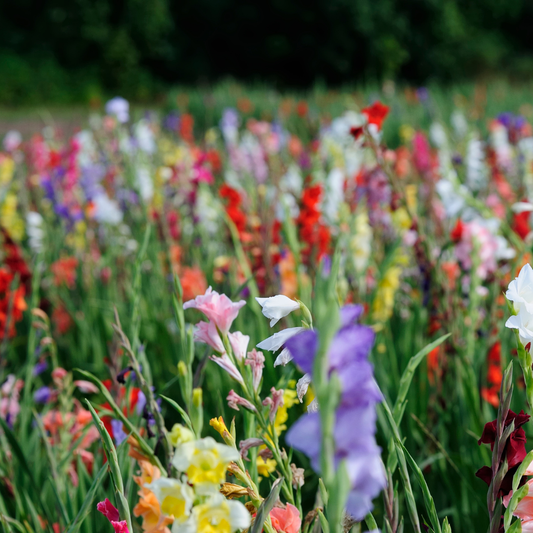
When to Plant Spring Onions?
Share
When to plant spring onions? Everything you need to know
Spring onions – also known as scallions or spring onions – are a delicious and easy vegetable to grow in your vegetable garden. They form beautiful, long stems and are ideal for salads, soups, or even barbecues. But when exactly do you plant them? And how do you ensure they grow well? You'll find out here, neatly and playfully compiled for the novice (and curious) gardener.
What exactly are spring onions?
For those wondering: spring onions aren't the same as regular onions or shallots. They don't form a thick bulb, but rather a long, slender stalk with a fresh, oniony flavor. So, you're more likely to use the stalk than the underground bulb. Despite their simple flavor, they add a refreshing touch to your dishes and are easy to grow.
The perfect planting moment in open ground
The best time to plant spring onions in the open ground is between March and May. When the weather becomes mild and there's little chance of a hard frost, you can get started in the garden. Ideally, choose a cloudy or rainy day – this will prevent your seedlings from immediately drying out or getting sunburned.
Provide loose, well-draining soil without excessive fertilizer. Work in some compost or potting soil (such as our vegetable potting soil ) to give your spring onions a good start. Sow them 1 to 2 cm deep in rows, with about 15 to 20 cm between rows. Thin them later to make room for strong specimens.
In the greenhouse: harvest earlier and faster
Are you lucky enough to have a greenhouse? Then you can plant spring onions earlier – even from February. The greenhouse protects young plants from cold, wind, and frost. Just make sure the temperature doesn't drop too low at night. A greenhouse also collects moisture more quickly, so be sure to check the soil carefully to make sure it doesn't get too wet.
You can also sow spring onions in pots or containers in your greenhouse. Ensure adequate drainage and use, for example, hydroponic clays at the bottom to prevent root rot. Here too, choose a gray day for sowing or sow early in the morning when it's still cool.
Direct sowing or pre-sowing?
Spring onions are usually sown directly in their final location. They don't like being pricked out or repotted. If you prefer to sow in advance, use a shallow pot and transplant the young plant outdoors or into the greenhouse as soon as it's large enough to stand firmly.
Want to get the most out of your space and are you a fan of growing your own? Then our grow kits are definitely worth considering – even for other edible plants!
Care after planting
Your spring onion mainly needs water and some sun – not excessive feeding. It's best to water it in the morning or evening so the water has a chance to soak in. Water less on very rainy days, otherwise you risk mold forming near the roots.
Weeds can quickly take over, so keep your rows tidy. Mulching isn't necessary, but a little coconut husk is fine for a warm and airy soil. Be careful with pesticides or other products, especially if you like to eat spring onions raw in salads.
When do you harvest spring onions?
You can harvest the young stems starting eight weeks after planting – even sooner if you started in a greenhouse. A good rule of thumb: about 30 cm long, with sturdy stems. Cut just above the roots with a sharp knife and feel free to let some of the younger ones continue to grow.
You can also sow spring onions in waves. Sow a new row every two to three weeks for a longer harvest period. This way, you can enjoy fresh spring onions in both spring and summer. As a bonus, you can also replant the tops of harvested stems as cuttings. Feel free to experiment!
Which plants go well with spring onions?
Companion planting is a good idea. Plant spring onions near carrots, lettuce, or beets, for example. They'll keep snails and certain insects at bay. Caladium also enjoys a bit of shade and can even provide some shelter for young onions in your greenhouse.
Going for a complete salad greenhouse? Then add easy-to-maintain plants like the robust ZZ Plant or a touch of tropical flair with a Monstera Minima next to your seed tray.
Frequently asked questions about planting spring onions
Can I also grow spring onions in pots?
Yes, absolutely! Ideally, choose a deeper pot of at least 20 cm and use airy, nutrient-rich potting soil with some perlite for drainage. Place the pot in a sunny spot and water regularly, especially on warm days. Within a few months, you'll have crispy spring onions for toast or a stir-fry.
What if my spring onions aren't growing?
Spring onions are quite easy to grow, but they need warmth and light. If the weather stays cold for a long time or you've sown too close together, they may lag behind. Aerate the soil, consider adding a little organic fertilizer, and check that your plants have enough room to grow. Don't forget to loosen the soil regularly!
Ready to plant?
Whether you're growing in your garden, greenhouse, or balcony, spring onions are a great choice for both beginners and seasoned plant enthusiasts. With a little love (and timing), you'll have a fresh supply of onions in no time, adding a refreshing touch to your salad, soup, or dish. Want to know everything about planting other onion varieties? Also read our blog post about when to plant onions and shallots .
For your garden project, you might still need the right tools, such as hydroponic clays or light potting soil. You'll find everything you need at De Plantrekkers – or visit our store in Leuven for personalized advice. We're happy to help!


